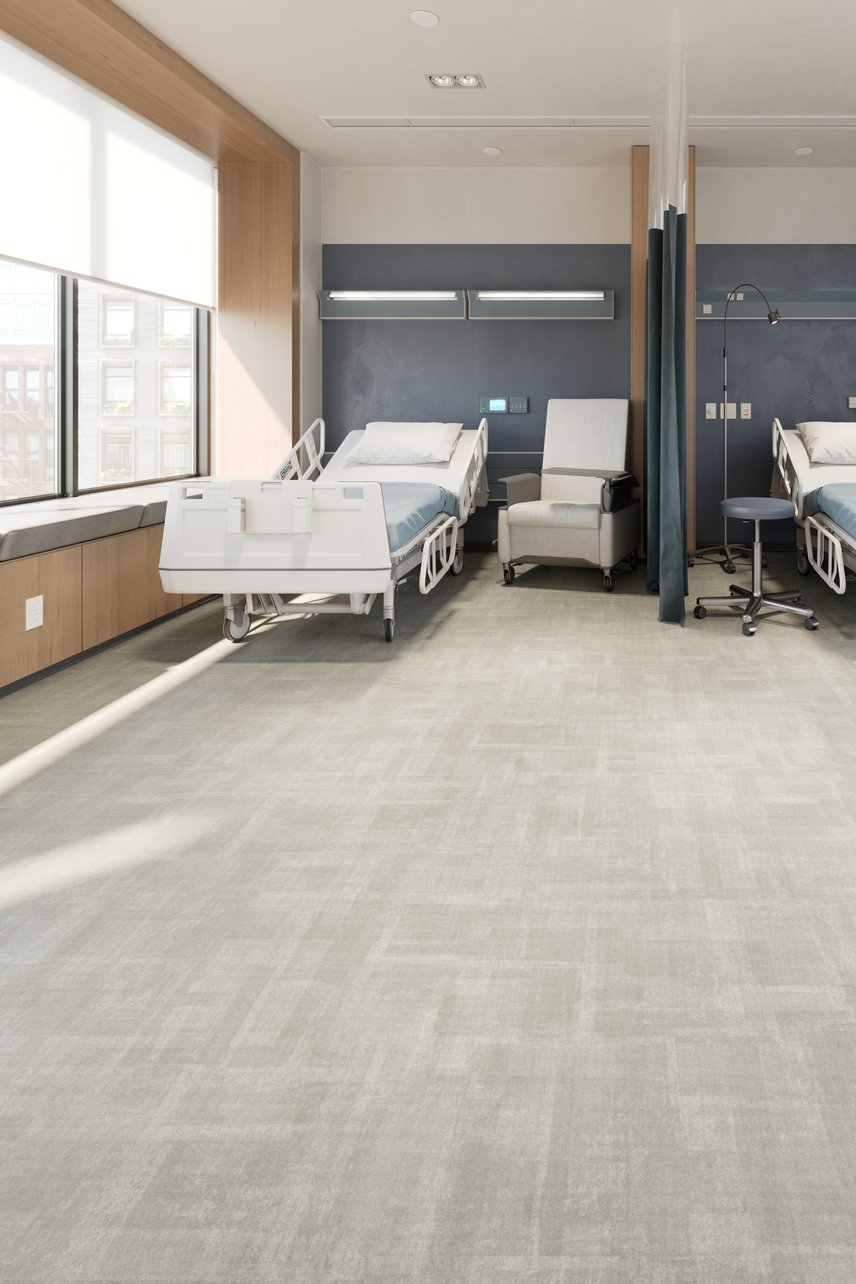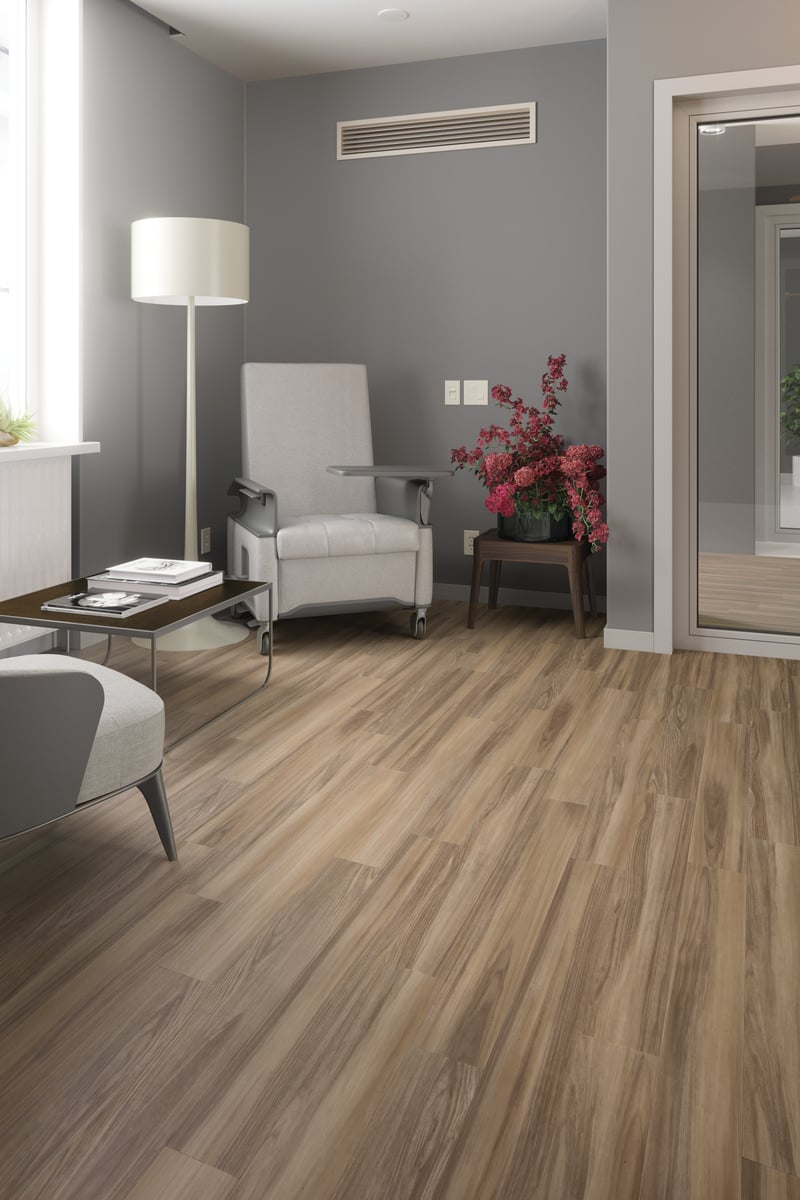As Director of Healthcare for Mannington Commercial, I work closely with designers and end-users to address the challenges of the healing environment. In my 20 years of experience I've learned a few tips for choosing the right flooring products for the patient rooms.
Today's patient rooms are designed to be easy for caregivers to maneuver within, safe for the patient, open and bright, cleanable, and supportive of family visits.
Large windows fill the room with light. There's a priority to reduce the patient's slip and fall. A quiet and clean environment is desired as the overall patient experience based on age cap survey can increase reimbursements for hospital. Finally, room readiness is top of mind for our end user. Finishes must be easy to clean and maintain. In this article we'll review my top 4 tips to choosing the right flooring products to meet these expectations.
Tip #1: Consider The Lighting
Now let's take a look at a pro tip, understanding hard light source. Within the modern healing environment, natural light and larger windows have created some challenges. Windows and the sun's impact will cast varying light into a room. These hard light sources cast shadows that produce visible hard edges on floors. Some floor imperfections are magnified under hard light conditions.
Luxury Vinyl Tile that is run parallel to a light source will also show the effect of hard light. To minimize the impact of hard light, proper floor preparation is a must.
- The use of sheet flooring can minimize hard light edges cast to the floor.
- When using LVT, run LVT perpendicular to that light source.
Tip #2: Consider The Flooring Product
Let's take a look at product application as it pertains to slip and fall challenges. The majority of patient falls in a hospital take place within a foot from the bed and in the bathroom.
Often, designers and end users select product based on visual interest and infection control properties. Mannington Commercial sheet, LVT & Legato all have a durable commercial wear layer - Quantum Guard technologies, that provides a patient comfortable footing throughout their recovery space.
Related: A Guide To Understanding the Fundamentals of Healthcare Flooring
Mannington Select, Hillside Walnut Palomino
Tip #3: What About Sound?
Let's take a look at how ratings of sound on our specifications can assist in specifying our product. Designers are always looking for interior finishes to provide a quieter environment within the healing space.
Within our published product specifications, we reference IIC and STC ratings. IIC denotes how much impact noise is stopped between floors, and STC rating denotes the noise within a space or room. We typically see our Resilient products STC ratings around 61 to 63, and we've found that STC ratings relays very well to the patient caregiver experience. Managing sound within a space is a true holistic effort.
The substrate, wall, ceiling, flooring, and related finishes, (including; windows, bed curtains, and window coverings) all contribute to the quality of how quiet a room can be. With this in mind, it is good to know that a room rated at a 50 STC is considered a good score. With this rating, it would require an effort to hear a conversation in the adjoining room.
Here's a quick reference on how our product specifications stack up...
Using flooring options like BioSpec SR, Assurance III (slip resistant) and ColorFields rubber sheet may require additional maintenance within the patient room. Although suited for the patient room, additional time required for daily maintenance and room turns may put these products in a category that will require a periodic deep clean. This may not be desirable for your end-use client and should be considered when suggesting finishes for the patient room.
Tip #4: What’s The Width of Your Roll?
Well, a conversation about what products work within the patient room would not be complete if roll width was not mentioned. A variety of roll widths allows you to minimize seaming. Mannington Commercial proudly manufactures our sheet in the USA and we are currently the only manufacturer offering multiple widths of sheet product.
In the image above, our client wanted an organic inspired product that was capable within the patient room to promote their client's infection control demands. I was fortunate enough to work with one of our DMs as he guided the designer to select our heterogeneous sheet product. The variety of product width enabled the designer to minimize seaming.
One fascinating outcome of this process is that once design is set and we produce the material in our Salem, NJ plant, our internal team can identify what actual rolls go where within the design - a true value add!
Related: Sheet Vinyl vs. Luxury Vinyl Tile: Best Flooring For Infection Control
The Bottom Line
Mannington offers additional services that highlight how to utilize our product. One such service is our design solutions team. Our design solution team further differentiates why Mannington Commercial understands the healing space.
Whether used to assist the designer in visualizing the potential of Mannington flooring or coordinating concept ideas with the end user, this service can enhance the client experience and assist you in securing additional work.
Do you specify for healthcare spaces? We have a helpful guide for you!
The Guide to Understanding the Fundamentals of Healthcare Flooring.
Click below for your free copy.👇



